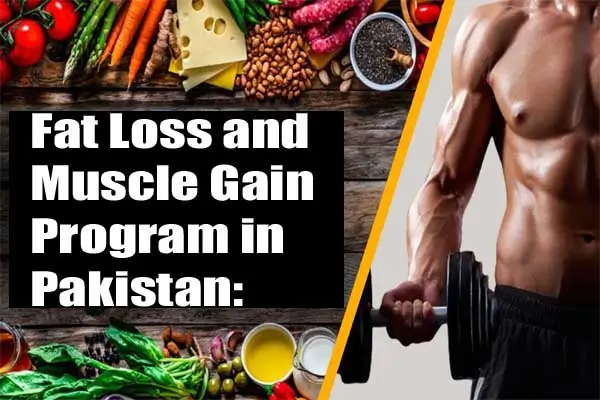Achieving fat loss and muscle gain simultaneously is a goal that requires a well-structured plan, discipline, and a balanced approach. For people in Pakistan, navigating this journey can be influenced by local dietary habits, cultural norms, and accessibility to fitness facilities. This guide is tailored to help you design an effective fat loss and muscle gain program using locally available resources and practical steps that fit your lifestyle.
Understanding the Basics
Before diving into a program, it’s crucial to understand the principles behind fat loss and muscle gain:
- Caloric Deficit for Fat Loss
- Fat loss occurs when you burn more calories than you consume. Adjusting your diet and incorporating physical activity can help.
- Caloric Surplus for Muscle Gain
- Building muscle requires consuming slightly more calories than you burn and strength training to stimulate muscle growth.
- Body Recomposition
- It is possible to lose fat and gain muscle simultaneously, especially for beginners, those returning to exercise after a break, or individuals with a higher body fat percentage. The key is balancing nutrition and exercise strategically.
Step-by-Step Guide to Fat Loss and Muscle Gain
Step 1: Assess Your Current State
Start by understanding your body composition and setting realistic goals. Use the following methods:
- Body Mass Index (BMI): Determine your weight category.
- Body Fat Percentage: Use callipers or visit a gym with a body composition analyzer.
- Photos and Measurements: Take before pictures and measure key areas like the waist, chest, arms, and thighs.
Read More: Affordable Meal Planning Services for Fitness: A Complete Guide
Set a realistic timeline. For example, aim for 0.5–1 kg of fat loss per week and noticeable muscle gain within 3–6 months.
Step 2: Customize Your Diet Plan
Your diet is the cornerstone of your success. Follow these steps to create a sustainable meal plan:
- Calculate Your Calorie Needs
- Use a calorie calculator to estimate your maintenance calories. Subtract 200–300 calories for fat loss or add 200–300 calories for muscle gain.
- Prioritize Protein
- Protein is essential for muscle repair and growth. Aim for 1.6–2.2 grams of protein per kilogram of body weight. For example:
- A 70 kg person should consume 112–154 grams of protein daily.
- Local protein sources in Pakistan:
- Chicken breast
- Fish (Rohu, Tuna)
- Eggs
- Lentils (Daal)
- Cottage cheese (Paneer)
- Include Complex Carbohydrates
- Carbs provide energy for workouts. Incorporate:
- Whole wheat roti
- Brown rice
- Oats
- Sweet potatoes
- Healthy Fats Are Essential
- Include sources like:
- Olive oil
- Desi ghee (in moderation)
- Nuts and seeds (almonds, flaxseeds)
- Plan Balanced Meals
- Example meal plan for a day:
- Breakfast: Oats with milk, a boiled egg, and an apple.
- Lunch: Grilled chicken, whole wheat roti, and a mixed vegetable salad.
- Dinner: Grilled fish, brown rice, and steamed broccoli.
- Snacks: A handful of almonds or a protein shake.
Step 3: Design Your Workout Routine
Exercise plays a critical role in fat loss and muscle gain. Follow this plan:
- Strength Training (4–5 Days a Week)
- Focus on compound exercises that target multiple muscle groups, such as:
- Squats
- Deadlifts
- Bench presses
- Pull-ups
- Rows
- Example split routine:
- Day 1: Upper body (push exercises like bench press and shoulder press)
- Day 2: Lower body (squats, lunges)
- Day 3: Rest or light activity
- Day 4: Upper body (pull exercises like pull-ups and rows)
- Day 5: Lower body (deadlifts, calf raises)
- Aim for 3–4 sets of 8–12 repetitions per exercise. Gradually increase weights to challenge your muscles.
- Cardio for Fat Loss (3–4 Days a Week)
- Combine moderate-intensity cardio (like brisk walking) with high-intensity interval training (HIIT):
- HIIT Example: Sprint for 30 seconds, walk for 90 seconds, and repeat for 20 minutes.
- Moderate-intensity cardio options: cycling, swimming, or jogging.
- Active Recovery and Flexibility (1–2 Days a Week)
- Incorporate yoga or stretching to improve mobility and prevent injuries.
Step 4: Track Your Progress
Regularly monitor your progress to ensure you’re on track. Use these methods:
- Weekly Check-ins: Weigh yourself once a week in the morning.
- Strength Gains: Record your lifts in the gym.
- Photos: Take progress photos every month.
- Measurements: Measure body parts to track muscle growth and fat loss.
Step 5: Adjust as Needed
If you hit a plateau, tweak your program:
- For Fat Loss: Decrease calories slightly or increase cardio.
- For Muscle Gain: Add more calories and adjust your workout intensity.
Practical Example: Localized Approach in Pakistan
Imagine Ali, a 28-year-old from Lahore, weighs 85 kg with 25% body fat. He wants to lose fat and build muscle. Here’s how he could apply to this program:
- Diet Plan for Ali:
- Maintenance calories: 2,500 kcal.
- Fat loss goal: Consume 2,200 kcal daily.
- Meals:
- Breakfast: 2 boiled eggs, a whole wheat paratha, and green tea.
- Lunch: Grilled chicken tikka, a medium-sized roti, and cucumber salad.
- Dinner: Fish curry (Rohu) with brown rice.
- Snacks: 10 almonds and a bowl of yoghurt.
- Workout Plan:
- Strength training at a local gym (e.g., squats, bench press).
- Morning jogs in the park for cardio.
- Active recovery on weekends with a cricket game.
- Monitoring:
- Ali tracks his weight and gym performance weekly. He consults his gym trainer to adjust weights or add HIIT if progress slows.
Common Challenges and How to Overcome Them
- Cultural Diet Preferences
- If you prefer traditional dishes, make healthier versions. For example:
- Use whole wheat flour for parathas.
- Grill kebabs instead of frying them.
- Limited Gym Access
- If a gym isn’t available, do bodyweight exercises like push-ups, squats, and burpees at home.
- Lack of Motivation
- Join a fitness group or find a workout buddy for accountability. Apps like MyFitnessPal can help you stay on track.
Staying Consistent
Consistency is the key to achieving fat loss and muscle gain. Here are tips to stay on track:
- Set Short-Term Goals: Break your long-term goal into smaller milestones.
- Prepare Meals in Advance: Avoid last-minute unhealthy food choices by meal prepping.
- Celebrate Wins: Reward yourself (non-food rewards) for progress.
Why Choose Bilal UK Fitness for Your Fat Loss and Muscle Gain Program?
At Bilal UK Fitness, I offer personalized fat loss and muscle gain programs to meet my client’s unique needs. As a UK-certified fitness Expert, I utilize proven methods to help you transform your body sustainably.
- Custom Diet Plans: Tailored meal plans designed to support fat loss and muscle gain, ensuring that you get the right nutrients at the right time.
- Personalized Workout Plans: A blend of strength training, HIIT (High-Intensity Interval Training), and cardio exercises to optimize fat loss and muscle growth.
- Expert Guidance: Regular consultations and progress tracking to ensure you’re on the right path and making steady progress.
- Affordable Services: My program starts at just Rs. 3000/month, offering exceptional value for a fitness plan designed by a certified professional.
The Science Behind Fat Loss and Muscle Gain
Before diving into the practical aspects of a fat loss and muscle gain program, it’s important to understand the science behind these processes.
Fat Loss Mechanisms
Fat loss occurs when your body uses stored fat as energy to meet its daily energy needs. Here are the key steps involved in fat loss:
- Caloric Deficit: By consuming fewer calories than you burn, your body becomes a caloric deficit, prompting it to use stored fat for energy.
- Fat Oxidation: When fat is broken down, it releases fatty acids and glycerol into the bloodstream, which are then transported to cells, particularly muscle cells, where they are burned for energy.
- Hormonal Balance: Hormones like insulin, cortisol, and growth hormone play a critical role in critical roles. Managing stress and eating a balanced diet can help regulate these hormones and reduce fat loss.
Muscle Gain Mechanisms
Muscle gain requires creating an environment where your muscles can grow and repair. The essential components for muscle growth are:
- Progressive Overload: This involves increasing the intensity, volume, or weight in your workouts to challenge your muscles and promote growth.
- Protein Synthesis: Protein is vital for muscle repair and growth. Consuming adequate protein helps stimulate muscle protein synthesis, ensuring your muscles recover and grow stronger after each workout.
- Rest and Recovery: Muscles grow during rest periods, so proper sleep and recovery are crucial for muscle building.
Balancing Fat Loss and Muscle Gain
While fat loss and muscle gain have opposing requirements (caloric deficit vs. surplus), it is possible to achieve both goals simultaneously. The key is:
- Slight Caloric Deficit: You don’t need a massive caloric deficit. A small one, combined with proper exercise, allows you to lose fat while maintaining muscle mass.
- High Protein Intake: Protein is essential for fat loss and muscle gain. It helps preserve muscle mass during weight loss and provides the building blocks for muscle growth during strength training.
- Strength Training and Cardio: Strength training and cardio can help burn fat while stimulating muscle growth.
Designing Your Fat Loss and Muscle Gain Program: The Essentials
It would help if you had a strategic plan focusing on nutrition, exercise, and lifestyle adjustments to achieve fat loss and muscle gain.
Nutrition for Fat Loss and Muscle Gain
Nutrition is the foundation of any fitness program. Without proper nutrition, fat loss and muscle gain are nearly impossible. Here’s how to tailor your diet:
- Calories: Stay in a slight caloric deficit, but avoid excessive restriction. A moderate caloric deficit (around 300-500 calories below your maintenance level) is sufficient to lose fat while preserving muscle.
- Protein: Consume 1.6-2.2 grams of protein per kilogram of body weight. Protein sources include chicken, fish, eggs, lean beef, and plant-based proteins like beans and tofu.
- Healthy Fats: Include sources of healthy fats such as olive oil, avocados, nuts, and seeds. Healthy fats support hormone production and overall health.
- Carbohydrates: Carbohydrates are essential for energy during workouts. Focus on complex carbs, such as brown rice, oats, and whole-wheat bread, which provide sustained energy.
- Meal Timing: Eat every 3-4 hours to maintain energy levels and support muscle protein synthesis. A post-workout meal with protein and carbs is essential for muscle recovery.
Exercise for Fat Loss and Muscle Gain
A well-rounded fitness routine should include both strength training and cardiovascular exercises.
- Strength Training: Incorporate full-body workouts focusing on compound movements like squats, deadlifts, bench presses, and pull-ups. These exercises engage multiple muscle groups and promote muscle growth.
- Progressive Overload: Gradually increase the weight, sets, or repetitions in your strength training workouts to continuously challenge your muscles.
- Cardio: Cardiovascular exercises like running, cycling, or HIIT (High-Intensity Interval Training) help burn fat. Aim for 2-3 weekly cardio sessions for fat loss without compromising muscle gain.
- Rest and Recovery: Get 7-9 hours of sleep per night to allow your muscles to recover and grow. Avoid overtraining, as recovery is when muscles rebuild and become stronger.
- Lifestyle Tips to Support Your Program
To maximize fat loss and muscle gain, consider these additional lifestyle tips:
- Hydration: Drink plenty of water daily to stay hydrated and support metabolic functions.
- Sleep: Quality sleep is vital for muscle recovery and fat loss. Aim for at least 7-8 hours of sleep per night.
- Stress Management: High-stress levels can interfere with fat loss and muscle gain—practice relaxation techniques like meditation or yoga to manage stress.
- Consistency: Achieving fat loss and muscle gain requires dedication and consistency. Stick to your workout and nutrition plan for long-term results.
Why Choose Bilal UK Fitness for Your Fat Loss and Muscle Gain Program?
As a UK Certified Fitness Expert, I provide professional and affordable programs tailored to your goals. Here’s how I can help:
- Personalized Plans: Based on your current fitness level, lifestyle, and goals, I’ll create a customized plan that includes specific workout and meal plans to maximize fat loss and muscle gain.
- Ongoing Support: With regular check-ins and progress tracking, I ensure you stay on track and make adjustments when necessary.
- Affordable Services: My fat loss and muscle gain program starts at Rs. 3000/- per month, offering great value for professional coaching and support.
- Results-Driven Approach: I focus on sustainable, long-term results. My plans keep you motivated and help you see tangible progress.
Visit my website, ukfitness. Online, to learn more about my services and start your fitness journey today.
Conclusion
Achieving fat loss and muscle gain is a challenging but rewarding journey. You can transform your body and achieve a lean, muscular physique with the right approach to nutrition, exercise, and lifestyle. Whether you want to lose weight, build muscle, or both, a well-rounded plan is essential for success.
Working with a professional like Bilal Islam, a UK-certified fitness Expert, gives you personalized guidance and support tailored to your unique needs. Start your fat loss and muscle gain program today and take the first step toward a healthier, stronger, and more confident you!


